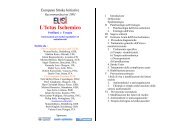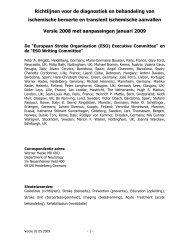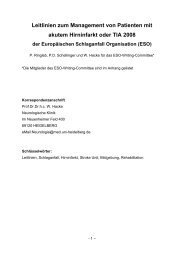Guidelines for Management of Ischaemic Stroke 2008 - ESO
Guidelines for Management of Ischaemic Stroke 2008 - ESO
Guidelines for Management of Ischaemic Stroke 2008 - ESO
You also want an ePaper? Increase the reach of your titles
YUMPU automatically turns print PDFs into web optimized ePapers that Google loves.
<strong>ESO</strong>-<strong>Guidelines</strong> <strong>for</strong> <strong>Management</strong> <strong>of</strong> <strong>Ischaemic</strong> <strong>Stroke</strong> <strong>2008</strong><br />
Preface<br />
This article represents the update <strong>of</strong> the European <strong>Stroke</strong> Initiative (EUSI)<br />
Recommendations <strong>for</strong> <strong>Stroke</strong> <strong>Management</strong>, which were first published in this journal<br />
in 2000 [1, 2], and subsequently translated into a number <strong>of</strong> languages including<br />
Spanish, Portuguese, Italian, German, Greek, Turkish, Lithuanian, Polish, Russian<br />
and Mandarin Chinese. The first update <strong>of</strong> the recommendations was published in<br />
2003 [2]. In 2006 the EUSI decided that a larger group <strong>of</strong> authors should prepare the<br />
next update. In the meantime, a new European <strong>Stroke</strong> Society, the European <strong>Stroke</strong><br />
Organisation (<strong>ESO</strong>), was established and took over the task <strong>of</strong> updating the<br />
guidelines. Accordingly, the new recommendations have been prepared by members<br />
<strong>of</strong> both the <strong>for</strong>mer EUSI Recommendations Writing Committee and the <strong>ESO</strong> (see<br />
appendix). The members <strong>of</strong> the Writing Group met in Heidelberg, Germany <strong>for</strong> 3<br />
days in December 2007 to finalize the new recommendations. The members <strong>of</strong> the<br />
Writing Committee were assigned to six groups covering different topics. Each group<br />
was co-chaired by two colleagues, and included up to five further experts. In order to<br />
avoid bias or conflict <strong>of</strong> interest none <strong>of</strong> the chairs had major involvement in clinical<br />
trials or studies discussed in their respective group. In addition, a detailed conflict <strong>of</strong><br />
interest disclosure <strong>for</strong>m is on file with the editor <strong>of</strong> the journal and attached to the<br />
electronic version <strong>of</strong> this article. However, due to the large number <strong>of</strong> authors, the<br />
detailed disclosures are not listed in the printed article.<br />
These guidelines cover both ischaemic stroke and transient ischaemic attacks (TIAs),<br />
which are now considered to be a single entity. If recommendations differ <strong>for</strong> the two<br />
conditions, this will be explicitly mentioned; otherwise the recommendations are valid<br />
<strong>for</strong> both conditions. Separate guidelines exist or are being prepared <strong>for</strong> intracerebral<br />
haemorrhage [3] and subarachnoid haemorrhage. The classes <strong>of</strong> evidence and<br />
levels <strong>of</strong> recommendations used in these guidelines are defined according to the<br />
criteria <strong>of</strong> the European Federation <strong>of</strong> Neurological Societies (EFNS) (Table 1,Table<br />
2). The manuscript covers referral and emergency management, <strong>Stroke</strong> Unit service,<br />
diagnostics, primary and secondary prevention, general stroke treatment, specific<br />
treatment including acute management, management <strong>of</strong> complications, and<br />
rehabilitation.<br />
- 4 -





